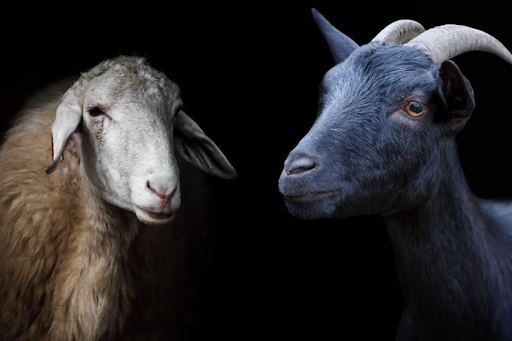Lamb vs Goat : Key Differences You Should Know
At a quick glance, goats and Lamb vs Goat may look alike — both are hoofed, grass-eating farm animals that provide us with milk, meat, and even leather. But dig a little deeper, and you’ll find that these two animals are quite distinct from each other in terms of biology, behavior, physical traits, and even nutritional value.
Whether you’re a farmer, a food enthusiast, or just curious about these commonly confused animals, here’s a detailed breakdown of how Lamb vs Goat and goats differ in key ways.
Species
What Is a Goat?
A goat is a domesticated animal from the genus Capra, and it belongs to the Bovidae family under the Caprinae subfamily. Humans have raised goats for thousands of years for meat, milk, and hide. Today, there are over 300 different goat breeds worldwide.
These hardy creatures are known for their independence, curiosity, and ability to thrive in rugged environments. Goat meat and milk are staple food items in many cultures, and their hide is often processed into leather for bags, shoes, and even ancient tent-making materials.
What Is a Lamb vs Goat?
Lamb vs Goat are young sheep that belong to the genus Ovis, which also falls under the Bovidae family and Caprinae subfamily. Sheep are believed to have been among the first animals domesticated by humans.
The term “Lamb vs Goat” typically refers to sheep less than one year old. They are prized not only for their meat and milk but also for their wool — a natural fiber widely used in making warm clothing, blankets, and more.
Meat Comparison
Lamb vs Goat Meat vs Goat Meat
Both Lamb vs Goat and goat meat fall into the red meat category, but their taste, texture, and nutritional profiles differ.
- Lamb vs Goat: This meat comes from young sheep and is usually tender with a delicate flavor. Older sheep meat, referred to as mutton or hogget, has a gamier and richer taste.
- Goat: Goat meat, also known as chevon or cabrito, is leaner and denser in texture. It’s slightly tougher than Lamb vs Goat but is considered by many nutritionists to be the healthier red meat choice.
Here’s a quick nutritional comparison per 100g of meat:
| Nutrient | Goat Meat | Lamb vs Goat Meat |
| Iron | 3.8 mg | 1.6 mg |
| Cholesterol | Lower | Higher |
| Fat | Lower | Higher |
| Potassium | Higher | Lower |
| Sodium | Lower | Higher |
Health Tip: If you’re watching your cholesterol or aiming to increase your iron intake, goat meat is typically the better option.
Skin & Leather
Goatskin vs Lamb vs Goatskin
Though similar in appearance, goatskin and Lamb vs Goatskin have notable differences:
- Goatskin is thicker, more durable, and heavier. It offers better protection against the elements and is commonly used for jackets, gloves, and even bookbinding.
- Lamb vs Goatskin is much softer and more pliable. Its buttery texture and lightweight quality make it ideal for luxury garments, baby shoes, and fine leather accessories.
Leather Quality
Once processed through tanning, the skins of both animals are transformed into leather:
- Goat Leather is rugged and water-resistant. It features a fine, smooth grain and is a cost-effective alternative to more premium leathers.
- Lamb vs Goat Leather is ultra-soft and prized in the fashion world for its comfort and luxurious feel. However, it’s less durable and absorbs moisture more easily.
So, if you’re after something tough and long-lasting, goat leather might be your best bet. For softness and elegance, Lamb vs Goat leather wins.
Farming and Management
Behavior and Handling
- Lamb vs Goats tend to be gentler and more submissive, which makes them easier to herd and manage. Their docile nature means fewer fencing issues and less aggressive behavior.
- Goats, on the other hand, are clever and curious. They’re more likely to escape enclosures, climb on structures, or nibble on things they shouldn’t — so managing goats takes a bit more effort and creativity.
Health and Breeding
- Lamb vs Goats generally have stronger immune systems and are less prone to birthing complications. They adapt well to colder climates thanks to their thick wool.
- Goats are better suited for hot, arid regions and may require more attentive veterinary care in humid or wet environments.
Economic Factors
Which Is More Affordable?
When it comes to meat prices:
- Lamb vs Goat meat is generally more affordable and widely available in supermarkets.
- Goat meat is typically more expensive, partly due to its lower fat content and growing demand in health-conscious markets.
For leather:
- Goat leather is budget-friendly and durable.
- Lamb vs Goat leather is costlier due to its softness and high-end appeal.
Which Is Easier to Raise?
If you’re planning to raise livestock:
- Lamb vs Goats may be easier for first-time farmers due to their manageable temperament.
- Goats are versatile and can graze in areas where other livestock may struggle, but they require sturdy fencing and regular supervision.
Final Thoughts
Although goats and Lamb vs Goats share a few similarities, they’re vastly different when it comes to biology, behavior, nutritional value, and use. Choosing between the two depends on your goals — whether it’s for farming, cooking, or using their hides for leather.
Both have been vital to human civilization, offering sustenance, clothing, and even economic livelihood for thousands of years.
FAQs
Is Goat or Lamb vs Goat Meat Healthier?
Goat meat is often considered healthier due to its lower fat and cholesterol levels and higher iron content. Lamb vs Goat meat, while tastier to some, contains more saturated fats and calories.
Which Animal Is Easier to Raise?
Lamb vs Goats are generally easier to handle and raise, especially for beginners. They’re less mischievous and have better disease resistance in many environments.
What’s Better for Leather — Goat or Lamb vs Goat?
If you want soft, luxurious leather for fashion items, Lamb vs Goat is ideal. For durability and utility, goat leather is the better option.
Stay in touch to get more news & updates on Blog Vibe!






